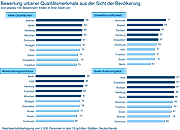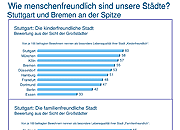Current research, 206
24. June 2008
„"This is a great place to live!" – German cities from the perspective of the population
BAT Foundation for Future Issues publishes new study on the city ranking of the 10 largest German cities
Worldwide, more and more people are drawn to cities. For the first time in human history, more than half the population lives in urban areas. But what is life like in Germany's major cities? How satisfied are residents with their cities? Where is the best and safest place to live? To answer these questions, residents of Germany's ten largest cities rated "their" city according to twenty different quality criteria, ranging from atmospheric and cosmopolitan to welcoming, senior-friendly, and family-friendly, as well as livable and prosperous. Almost all respondents agree: 84 percent of the population consider "their" city livable. At the same time, however, many cities are still far from realizing the ideal of a "human-centered city." Only about half of the major city dwellers consider their own city child-friendly (491%), family-friendly (551%), or senior-friendly (511%). This is the result of a recent representative survey by the BAT Foundation for Future Issues, in which 2,000 people aged 14 and over were asked to assess and evaluate "their" city.
Child-, family- and senior-friendly
In a comparison of cities with human-centered characteristics, Stuttgart, Bremen, Hamburg, and Cologne dominate. A clear majority of Stuttgart (601%), Cologne (571%), and Bremen (551%) residents consider their city child-friendly. Family-friendliness is even more highly regarded in Stuttgart (651%), followed by Dortmund (631%) and Bremen (611%). In contrast, Berlin and Essen rank near the bottom in a comparison of the ten largest cities. Only 42% of Berliners consider their city child-friendly; in Essen, only a third of the population (331%) agrees. Furthermore, family-friendly structures do not garner majority support in Essen (411%) or Berlin (481%).
Against the backdrop of demographic change, senior citizen policies in cities will take on particular importance in the coming years. Almost two-thirds of Bremen residents (621,000) are convinced of the senior-friendliness of "their" city. Residents of Stuttgart (581,000) and Hamburg (551,000) rate the quality of housing and life for the older population similarly positively. Professor Dr. Horst W. Opaschowski, Scientific Director of the BAT Foundation, states: "What's needed is a socially conscious, humane city. Those who fail to offer a child-, family-, and senior-friendly environment in their cities today are certainly investing in the wrong direction. The social consequence will be a shrinking, not a growing, city. In the future, cities will not only compete for older adults but also for the best kindergartens, all-day schools, and safest transportation routes."„
Wealthy and economically powerful
A comparison of Germany's ten largest cities reveals a wealth gap from the residents' perspective. City dwellers in Stuttgart (82%), Düsseldorf (81%), Hamburg (79%), Munich (78%), and Frankfurt (69%) perceive their cities as "prosperous," while those in Cologne (38%), Essen (29%), Bremen (24%), Berlin (19%), and Dortmund (14%) feel little of the same. And when it comes to perceived economic strength, there's a world of difference between Stuttgart residents (91%) and Berliners (44%). "Large cities and metropolitan regions often proudly highlight location factors such as economic strength and growth potential, the job market, and transport connections. In their rankings, they aim to attract investors, but in doing so, they largely lose sight of the quality of life for their residents," says Opaschowski. "For city dwellers, a sense of well-being and comfort go hand in hand. And for them, an urban atmosphere begins with a people-friendly design of the living environment."„
Cosmopolitan and growing
Together with the residents of Frankfurt, Hamburgers attest to their city's greatest cosmopolitanism (90%). They also have a very positive outlook regarding the city's growth (85%). Opaschowski: "Hamburg lives up to its reputation as a 'gateway to the world' within its own population; prosperity and internationalism are not only felt in the city center and the port. The surrounding commuter belt also benefits from the positive economic development of recent years." The Ruhr region metropolises of Essen and Dortmund have so far noticed little of this. Only half of Dortmund's residents (51%) and even fewer Essen's (44%) describe their city as growing.
Green and environmentally friendly
Germany's major cities are characterized by numerous parks, gardens, and recreational areas. Residents of Bremen (86%) are the most satisfied with the available green spaces, followed by the three major cities of Berlin, Hamburg, and Munich (each 83%). Nearly three-quarters of Frankfurt residents (73%) also find sufficient green spaces available. However, the picture is different when it comes to environmental friendliness. Significant differences exist between Munich (71%) and Berlin (43%). The capital city pays the price for its excellent transport and road network, which receives the highest rating (89%) of any other city. Opaschowski: "Politicians face a dilemma: if they prioritize expanded roads and smooth traffic flow, they must accept a decline in environmental quality. One solution could be the consistent improvement of public transport.".
Culturally diverse
From the perspective of the population, Cologne, Düsseldorf, and Stuttgart are considered Germany's cultural metropolises. Almost nine out of ten residents (87%) attest to the three cities' excellent cultural offerings. In contrast, only slightly more than two-thirds of Dortmund's residents (69%) express satisfaction with the available options and also criticize the lack of variety. Here, the capital city (88%) particularly shines. "Berlin isn't just attractive to tourists. Residents also benefit from their city's highlights and attractions," says the Scientific Director of the BAT Foundation.
Safe and clean
Munich and Stuttgart top the city rankings for safety (78%). Significantly lower approval ratings are found in Hamburg (48%), Bremen, and Cologne (both 47%). In Berlin, not even two out of five citizens (38%) feel safe. Residents of the capital also report major shortcomings in cleanliness. Only about one in four (24%) considers Berlin a clean city. In Munich, the figure is more than three times higher (82%). Opaschowski: "Berlin is struggling with the problems of a global city, while other cities are able to develop their own unique atmosphere."„
Atmospheric and welcoming
Cologne receives exceptionally high approval ratings for its urban atmosphere (89%) and hospitality (91%), which no other major city achieves. The difference to Dortmund is significant (atmosphere 57% – hospitality 74%). "The people of Cologne can practically bathe in atmosphere, and not just during Carnival season," says foundation director Opaschowski.
The future is happening in the city
The quality of life in Germany is among the highest in the world. This is also confirmed by the assessments of the residents themselves. The future of major cities will depend crucially on the extent to which they establish themselves as more than just economic or growth centers. The city of the future must offer more than office buildings and industrial facilities. Equally important is creating a positive self-image among city residents through internal marketing, so that the city remains a sustainable and livable place for everyone.







